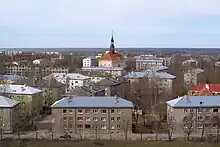Narva | |
|---|---|
City | |
 Narva's medieval Hermann Castle by the Narva river | |
 Flag  Coat of arms | |
| Coordinates: 59°22′33″N 28°11′46″E / 59.37583°N 28.19611°E | |
| Country | |
| County | |
| First mentioned | 1172 |
| City rights | 1345 |
| Government | |
| • Mayor | Jaan Toots |
| Area | |
| • Total | 84.54 km2 (32.63 sq mi) |
| Elevation | 25 m (82 ft) |
| Population (2023)[1] | |
| • Total | 53,626 |
| • Rank | 3rd |
| • Density | 630/km2 (1,600/sq mi) |
| Ethnicity (2011)[2] | |
| • Russians | 87.7% |
| • Estonians | 5.2% |
| • other | 7.1% |
| Time zone | UTC+2 (EET) |
| • Summer (DST) | UTC+3 (EEST) |
| Postal code | 20001 to 21020 |
| Area code | (+372) 035 |
| ISO 3166 code | EE-511 |
| Website | www.narva.ee |
Narva[lower-alpha 1] is a municipality and city in Estonia. It is located in the Ida-Viru County, at the eastern extreme point of Estonia, on the west bank of the Narva river which forms the Estonia–Russia international border. With 53,626 inhabitants (as of 2023) Narva is Estonia's third largest city after capital Tallinn and Tartu.
Narva was nearly completely destroyed in 1944 during World War II.[3] During the Soviet era of Estonia in 1944–1991, the city's original inhabitants were not permitted to return, and immigrant workers from Soviet Russia and other parts of the former Soviet Union (USSR) were introduced.[4][3] Narva’s population, 65% ethnic Estonian as of the 1934 census, became overwhelmingly non-Estonian in the second half of the 20th century.[4] According to more recent data, 46.7% of the city's inhabitants are citizens of Estonia, 36.3% are citizens of the Russian Federation, while 15.3% have undefined citizenship.[5]
History
Early settlement
People settled in the area from the 5th to 4th millennium BC, as evidenced by archeological findings of the Narva culture, named after the Narva river.[6] The fortified settlement at Narva Joaoru is the oldest known in Estonia, dated to around 1000 BC.[7] The earliest known written reference of the toponym Narva is in the First Novgorod Chronicle, which in the year 1172 describes a district in Novgorod called Nerevsky or Narovsky konets (yard). According to historians, this name probably derives from the name of the then village of Narva, or from the Narva river, and indicates that a frequently used trade route went through Narva, albeit no evidence of the existence of a trading settlement in Narva at the time has been found so far.[8]
Middle Ages
Narva's favourable location at the intersection of both trade routes and the Narva river was behind the founding of Narva castle and the subsequent development of the castle's surrounding urban settlement. The castle was founded during the Danish rule of northern Estonia in the second half of the 13th century; the earliest written record of the castle is from 1277.[9] Narvia village is mentioned in the Danish Census Book already in 1241. A town developed around the stronghold and in 1345 obtained Lübeck City Rights from Danish king Valdemar IV.[10] The castle and surrounding town of Narva (Narwa, in German) became a possession of the Livonian Order in 1346, after the Danish king sold its lands in Northern Estonia. In 1492, Ivangorod fortress across the Narva river was established by Ivan III of Moscow.
Trade, particularly Hanseatic long-distance trade remained Narva's raison d'être throughout the Middle Ages.[9] However, due to opposition from Tallinn, Narva itself never became part of the Hanseatic League and also remained a small town – its population in 1530 is estimated at 600–750 people.[9]
Swedish and Russian rule
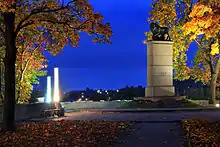

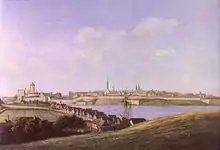
Captured by the Tsardom of Russia (Muscovy) during the Livonian War in 1558–1581, for a short period Narva became an important trading port and transshipment centre of Russian goods from Pskov and Novgorod. In 1581, the Swedish troops under the command of Pontus De la Gardie conquered the city and it became part of Sweden. During the Russo-Swedish War (1590–1595), when Arvid Stålarm was governor, Russian forces attempted to regain the city without success (Treaty of Teusina, May 1595).
During the Swedish rule, the baroque Old Town of Narva was built. Following a large fire in 1659 that almost completely destroyed the town, only stone buildings were allowed to be built in its central part. Income from flourishing trade allowed rebuilding of the town center in two decades.[10] Until World War II, the baroque architecture of the Old Town underwent practically no changes, and it became renowned all over Europe. Towards the end of Swedish rule, the defence structures of Narva were greatly improved. Beginning in 1680s, an outstanding system of bastions was designed by renowned military engineer Erik Dahlbergh and built around the town. The new defences were among the most powerful in Northern Europe.[10]
During the Great Northern War of 1700–1721, Narva became the setting for the first great battle between the forces of King Charles XII of Sweden and Tsar Peter I of Russia (Muscovy) in November 1700. Although outnumbered four to one, the Swedish forces routed their 40,000-strong opponent. Tsardom of Russia subsequently conquered the city in 1704.
After the Great Northern War, the bastions were renovated. Narva remained on the list of fortifications of the Russian Empire until 1863, although there turned out to be no real military need for it.[10] Administratively the city of Narva, including its then suburb of Ivangorod (Jaanilinn) was a part of the Saint Petersburg Governorate of the Russian Empire until 1917.
In the middle of the 19th century, Narva developed into a major industrial city. Ludwig Knoop established the Krenholm Manufacturing Company in 1857. The factory used the affordable energy of the powerful Narva waterfalls, and at the end of the century became, with about 10,000 workers, one of the largest cotton mills in Europe and the world.[11] In 1872, Krenholm Manufacturing became the site of the first strike in Estonia.[12] At the end of the 19th century, Narva was the leading industrial town in Estonia – 41% of industrial workers in Estonia worked in Narva, compared to 33% in Tallinn.[12] The first railway in Estonia, completed in 1870, connected Narva to Saint Petersburg and to Tallinn.
In August 1890, Narva was the site of a key meeting between German Kaiser Wilhelm II and Russian Tsar Alexander III.
Post-World War I period
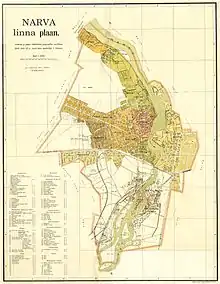
The status of Narva was resolved in a July 1917 referendum, when the district population, at that time roughly equally divided between ethnic Russians and Estonians, voted to attach itself to the newly autonomous, and soon to be independent state of, Estonia.[13] Narva became part of the independent Republic of Estonia in 1918, at the end of World War I. The town saw fighting during the Estonian War of Independence. The war started when Russian Bolshevik troops attacked Narva on 28 November 1918, capturing the city on the next day. The Russian bolshevik troops retained control of the city until 19 January 1919.[14]

Heavy battles occurred both in and around Narva during World War II. The city was damaged in the German invasion of 1941 and by smaller air raids throughout the war, but remained relatively intact until February 1944.[3] However, as the focus of the Battle of Narva, the city was destroyed by Soviet bombardment and fires and explosions set by retreating German troops.[15] The most devastating action was the bombing raids of 6 and 7 March 1944 by the Soviet Air Force, which destroyed the Baroque old town.[10][3]
Soviet occupation 1944–1991
By the end of July 1944, 98 per cent of Narva had been destroyed.[3] After the war, most of the buildings could have been restored as the walls of the houses still existed, but in early 1950s, the Soviet authorities decided to demolish the ruins to make room for apartment buildings.[3][16] Only three buildings remain of the old town, including the Baroque-style Town Hall.[17] The civilian casualties of the bombing were low as the German forces had evacuated the city in January 1944.
The original native inhabitants were not allowed to return after the war, and immigrant Russian-speaking workers from other parts of the USSR were brought in to populate the city.[4][3] The city which population had been 65% Estonian according to the last census in 1934, became overwhelmingly non-Estonian.[4] The main reason behind this was a plan to build a secret uranium processing plant in the city, which would turn Narva into a closed town.[16] In 1947 nearby Sillamäe was selected as the location of the factory instead of Narva, but the existence of such a plan was decisive for the development of Narva in the postwar years, and thus also shaped its later evolution.[18] The planned uranium factory and other large-scale industrial developments, like the restoring of Kreenholm Manufacture, were the driving force behind the influx of internal migrants from other parts of the Soviet Union, mainly Russia.[18]
In January 1945, Jaanilinn (Ivangorod), the suburb on the eastern bank of the river was separated from Estonia (and from Narva) by the Soviet authorities, and the settlement around Ivangorod fortress was made administratively part of the neighboring Leningrad Oblast of the Russian SFSR. In 1954, Ivangorod became officially a town in its own rights.
Restoration of Estonian independence
After Estonia regained its independence in 1991, the city's leaders, holdovers from the Soviet era, wanted autonomy, and contended that the notion of a breakaway "Transnarovan Soviet republic" in northeastern Estonia was becoming increasingly popular, but this was contradicted by polls showing 87% of the region's population opposed secession from Estonia.[13]
In 1993, dissatisfaction with newly enacted citizenship and election laws (non-citizens were not allowed to hold office) culminated in the Narva referendum of 16–17 July 1993, which proposed autonomy for both Narva and Sillamäe, a nearby town.[13] Although 97% voted in favor of the referendum, turnout in Narva was a mere 55%, and there were credible charges of vote rigging.[13]

After 1991, disputes regarding the Estonian-Russian border in the Narva sector remained, as the new constitution of Estonia (adopted in 1992) recognizes the 1920 Treaty of Tartu border to be currently legal.
The Russian Federation, however, considers Estonia to be a successor of the Estonian SSR and recognizes the 1945 border between the two former national republics. Officially, Estonia has no territorial claims in the area, and which was also reflected in the new Estonian-Russian border treaty signed in Moscow on 18 May 2005.[19][20][21] Russia failed to ratify it because, together with the ratification the Estonian parliament, approved a communiqué, which mentioned the Soviet Occupation.
On 18 February 2014 a new border treaty was signed by both countries.[22] However the treaty was not ratified by the parliaments of either Russia or Estonia.[23]
Overall, by 2014, Russian residents were happy with their status as both Estonian and European Union citizens and lived peacefully alongside their compatriots.[24]
Before the 2022 Russian invasion of Ukraine, residents mixed relatively freely with the residents across the river in Ivangorod.[25]

Those on the Estonian side mainly crossed to buy cheaper petrol, groats, cleaning products, pasta and sugar.[25] Those crossing from the Russian side wanted to make use of the availability of non-sanctioned goods, entertainment facilities and overall better infrastructure.[25]
The invasion and subsequent conflict seriously reduced cooperation between the two neighbours, especially as visas became difficult to obtain and the residents of Narva increased the take up in Estonian citizenship.[25] Narva took many Ukrainian refugees fleeing the war[25] and previously popular Russian TV stations among older Russophone residents were banned by the Estonian government.[25]
On 10 June 2022, the Estonian foreign ministry summoned the Russian ambassador to protest about remarks by President Vladimir Putin praising Peter the Great for having captured Narva in the early 18th century.[26]
In August 2022, a Soviet T-34 tank memorial was removed from a stretch of road between the city centre and Narva-Jõesuu, to mixed responses. It was moved to the Estonian War Museum near Tallinn.[27] In response to the tank's removal, the following month Russian authorities erected a similar T-34 tank monument in Ivangorod near the border crossing point with Narva.[28]
Demographics
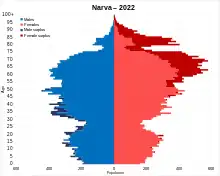
On 1 January 2013 Narva's population was 59,888, down from 60,454 inhabitants a year earlier.[29] The population was 83,000 in 1992.[30] 95.7% of the population of Narva are native Russian speakers,[31] and 87.7% are ethnic Russians.[2] Most non-Estonians are ethnically Russian, Belarusian, or Ukrainian immigrants or the children of immigrants, though 69% of Narva residents in the early 1990s had been born in Narva or had lived there for more than 30 years.[13] Ethnic Estonians account for 5.2% of total population.[2] Much of the city was destroyed during World War II and for several years during the following reconstruction the Soviet authorities largely prohibited return of Narva's pre-war residents (among whom ethnic Estonians had been the majority, forming 64.8% of the town's population of 23,512 according to the 1934 census),[32] thus radically altering the city's ethnic composition.[12] Nevertheless, ethnic Russians had already formed a significant minority: 29.7% of the city's population were Russian in the census of 1934.
46.7% of the city's inhabitants are Estonian citizens, 36.3% are citizens of the Russian Federation, while 15.3% of the population has undefined citizenship.[5] Since the 2022 Russian invasion of Ukraine there has been increased the take up in Estonian citizenship in the city.[25]
A concern in Narva is the spread of HIV, which infected 1.2% of Estonia's population in 2012.[33] Between 2001 and 2008, more than 1,600 cases of HIV were registered in Narva, making it one of the worst areas in Estonia, alongside Tallinn and the rest of Ida-Viru County.[34] The HIV infection rate in Estonia declined in 2014, with 59 new cases in Narva.[35]
| Ethnicity | 1897 | 1922[36] | 1934[37] | 1941[38] | 1959[39] | 1970[40] | 1979[41] | 1989[41] | 2000[42] | 2011[43] | 2021[44] | |||||||||||
|---|---|---|---|---|---|---|---|---|---|---|---|---|---|---|---|---|---|---|---|---|---|---|
| amount | % | amount | % | amount | % | amount | % | amount | % | amount | % | amount | % | amount | % | amount | % | amount | % | amount | % | |
| Estonians | 7313 | 44.0 | 17501 | 65.0 | 15227 | 64.8 | 13625 | 68.7 | 3114 | 11.3 | 3984 | 6.89 | 3538 | 4.86 | 3224 | 3.97 | 3331 | 4.85 | 3031 | 5.17 | 3107 | 5.76 |
| Russians | 7217 | 43.5 | 7927 | 29.5 | 6986 | 29.7 | 5376 | 27.1 | - | - | 48205 | 83.3 | 61971 | 85.1 | 69763 | 85.9 | 58702 | 85.5 | 51434 | 87.7 | 46937 | 87.0 |
| Ukrainians | 7 | 0.04 | - | - | 1 | 0.00 | - | - | - | - | 1448 | 2.50 | 2092 | 2.87 | 2626 | 3.23 | 1774 | 2.58 | 1219 | 2.08 | 1140 | 2.11 |
| Belarusians | 63 | 0.38 | - | - | - | - | - | - | - | - | 1526 | 2.64 | 1904 | 2.62 | 2182 | 2.69 | 1529 | 2.23 | 1034 | 1.76 | 833 | 1.54 |
| Finns | 99 | 0.60 | - | - | 211 | 0.90 | 369 | 1.86 | - | - | 689 | 1.19 | 780 | 1.07 | 727 | 0.90 | 682 | 0.99 | 406 | 0.69 | 325 | 0.60 |
| Jews | - | - | 318 | 1.18 | 188 | 0.80 | 0 | 0.00 | - | - | 219 | 0.38 | 219 | 0.30 | 211 | 0.26 | 89 | 0.13 | 61 | 0.10 | 48 | 0.09 |
| Latvians | - | - | - | - | 65 | 0.28 | 46 | 0.23 | - | - | 189 | 0.33 | 191 | 0.26 | 185 | 0.23 | 147 | 0.21 | 83 | 0.14 | 85 | 0.16 |
| Germans | 1000 | 6.02 | 502 | 1.87 | 499 | 2.12 | - | - | - | - | - | - | 279 | 0.38 | 251 | 0.31 | 218 | 0.32 | 141 | 0.24 | 124 | 0.23 |
| Tatars | - | - | - | - | 59 | 0.25 | - | - | - | - | - | - | 414 | 0.57 | 479 | 0.59 | 376 | 0.55 | 271 | 0.46 | 237 | 0.44 |
| Poles | - | - | - | - | 162 | 0.69 | 116 | 0.59 | - | - | - | - | 148 | 0.20 | 159 | 0.20 | 127 | 0.18 | 95 | 0.16 | 88 | 0.16 |
| Lithuanians | - | - | - | - | 21 | 0.09 | 18 | 0.09 | - | - | 191 | 0.33 | 200 | 0.27 | 180 | 0.22 | 141 | 0.21 | 114 | 0.19 | 125 | 0.23 |
| unknown | - | - | 18 | 0.07 | 15 | 0.06 | 9 | 0.05 | 0 | 0.00 | 0 | 0.00 | 0 | 0.00 | 0 | 0.00 | 744 | 1.08 | 60 | 0.10 | 44 | 0.08 |
| other | 900 | 5.42 | 646 | 2.40 | 78 | 0.33 | 265 | 1.34 | 24516 | 88.7 | 1412 | 2.44 | 1047 | 1.44 | 1234 | 1.52 | 820 | 1.19 | 714 | 1.22 | 862 | 1.60 |
| Total | 16599 | 100 | 26912 | 100 | 23512 | 100 | 19824 | 100 | 27630 | 100 | 57863 | 100 | 72783 | 100 | 81221 | 100 | 68680 | 100 | 58663 | 100 | 53955 | 100 |
Religion in Narva (2021)[45]
Geography
Narva is situated in the eastern extreme point of Estonia, 200 km (124 mi) to the east from the Estonian capital Tallinn and 130 km (81 mi) southwest from Saint Petersburg. The capital of Ida-Viru County, Jõhvi, lies 50 km (31 mi) to the west. The eastern border of the city along the Narva river (which drains Lake Peipus) coincides with the Estonian-Russian border. The Estonian part of the Narva Reservoir lies mostly within the territory of Narva, to the southwest of city center. The mouth of the Narva river to the Gulf of Finland is about 13 km (8 mi) downstream from the city.
The municipality of Narva covers 84.54 km2 (32.64 sq mi), of which the city proper occupies 62 km2 (24 sq mi) (excluding the reservoir), while two separate districts surrounded by Vaivara Parish, Kudruküla and Olgina, cover 5.6 km2 (2.16 sq mi) and 0.58 km2 (0.22 sq mi), respectively.[46] Kudruküla is the largest of Narva's dacha regions, located 6 km (4 mi) to northwest from the main city, near Narva-Jõesuu.
Climate
Narva has a warm-summer humid continental climate (Köppen climate classification Dfb) with mild to warm, rainy summers with cool nights and cold, cloudy and snowy winters. Narva is one of the coldest settlements in Estonia, being located at the very northeast of the country and bordering Russia.
| Climate data for Narva, 1971–2000 normals, extremes 1928–present | |||||||||||||
|---|---|---|---|---|---|---|---|---|---|---|---|---|---|
| Month | Jan | Feb | Mar | Apr | May | Jun | Jul | Aug | Sep | Oct | Nov | Dec | Year |
| Record high °C (°F) | 8.9 (48.0) |
10.6 (51.1) |
16.0 (60.8) |
25.7 (78.3) |
31.7 (89.1) |
34.6 (94.3) |
34.5 (94.1) |
35.4 (95.7) |
29.9 (85.8) |
21.0 (69.8) |
12.5 (54.5) |
10.4 (50.7) |
35.4 (95.7) |
| Mean daily maximum °C (°F) | −3.2 (26.2) |
−3.1 (26.4) |
1.6 (34.9) |
8.7 (47.7) |
15.7 (60.3) |
19.9 (67.8) |
21.7 (71.1) |
20.2 (68.4) |
14.4 (57.9) |
8.3 (46.9) |
2.0 (35.6) |
−1.4 (29.5) |
8.7 (47.7) |
| Daily mean °C (°F) | −5.8 (21.6) |
−6.2 (20.8) |
−2.0 (28.4) |
4.0 (39.2) |
10.1 (50.2) |
14.8 (58.6) |
16.9 (62.4) |
15.4 (59.7) |
10.3 (50.5) |
5.4 (41.7) |
−0.1 (31.8) |
−3.8 (25.2) |
4.9 (40.8) |
| Mean daily minimum °C (°F) | −8.9 (16.0) |
−9.7 (14.5) |
−5.4 (22.3) |
−0.1 (31.8) |
4.4 (39.9) |
9.3 (48.7) |
11.7 (53.1) |
10.7 (51.3) |
6.3 (43.3) |
2.5 (36.5) |
−2.5 (27.5) |
−6.7 (19.9) |
0.9 (33.6) |
| Record low °C (°F) | −39.4 (−38.9) |
−37.4 (−35.3) |
−32.7 (−26.9) |
−25.1 (−13.2) |
−6.3 (20.7) |
−0.9 (30.4) |
2.3 (36.1) |
−0.5 (31.1) |
−5.4 (22.3) |
−12.4 (9.7) |
−22.9 (−9.2) |
−42.6 (−44.7) |
−42.6 (−44.7) |
| Average precipitation mm (inches) | 36 (1.4) |
28 (1.1) |
33 (1.3) |
32 (1.3) |
43 (1.7) |
62 (2.4) |
75 (3.0) |
89 (3.5) |
76 (3.0) |
72 (2.8) |
54 (2.1) |
47 (1.9) |
646 (25.4) |
| Average precipitation days (≥ 1.0 mm) | 11 | 8 | 9 | 8 | 7 | 9 | 10 | 11 | 12 | 13 | 14 | 12 | 124 |
| Average relative humidity (%) | 86 | 84 | 79 | 72 | 67 | 73 | 76 | 79 | 83 | 84 | 87 | 87 | 80 |
| Mean monthly sunshine hours | 29.6 | 60.3 | 123.9 | 178.4 | 274.5 | 284.0 | 286.7 | 231.0 | 133.2 | 76.0 | 26.8 | 16.5 | 1,718.7 |
| Source: Estonian Weather Service[47][48][49][50] | |||||||||||||
| Coastal temperature data for Narva-Jõesuu | |||||||||||||
|---|---|---|---|---|---|---|---|---|---|---|---|---|---|
| Month | Jan | Feb | Mar | Apr | May | Jun | Jul | Aug | Sep | Oct | Nov | Dec | Year |
| Average sea temperature °C (°F) | 0.1 (32.18) |
-0.4 (31.28) |
-0.2 (31.64) |
1.3 (34.34) |
7.2 (44.96) |
14.6 (58.28) |
19.4 (66.92) |
18.7 (65.66) |
15.1 (59.18) |
10.2 (50.36) |
6.1 (42.98) |
3.0 (37.40) |
7.9 (46.27) |
| Source 1: Seatemperature.org[51] | |||||||||||||
Neighbourhoods
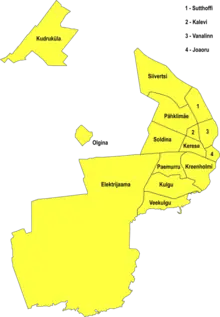
Narva is officially divided into 15 neighbourhoods: Elektrijaama, Joaoru, Kalevi, Kerese, Kreenholmi, Kudruküla, Kulgu, Olgina, Paemurru, Pähklimäe, Siivertsi, Soldina, Sutthoffi, Vanalinn and Veekulgu.
Landmarks
Narva's skyline is dominated by the 15th-century castle, with the 51-meter-tall (167 ft) Pikk Hermann tower as its most prominent landmark. The sprawling complex of the Kreenholm Manufacture, located in the proximity of scenic waterfalls, is one of the largest textile mills of 19th-century Northern Europe. Other notable buildings include Swedish mansions of the 17th century, a Baroque town hall (1668–71), and remains of Erik Dahlberg's fortifications.
Across the Narva river lies the Russian Ivangorod fortress, established during the rule of Grand Prince Ivan III of Muscovy in 1492 and also referred to in some contemporary sources as the "Counter-Narva". From the 17th century until 1945, both the fortress and the adjacent suburb of Ivangorod (Estonian: Jaanilinn) were an administrative part of Narva.
Narva Kreenholmi Stadium is home to Meistriliiga football team, FC Narva Trans.
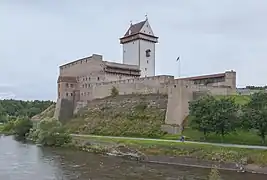
.jpg.webp) Town Hall
Town Hall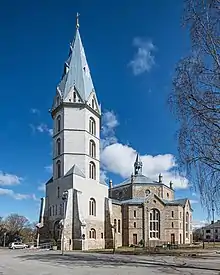
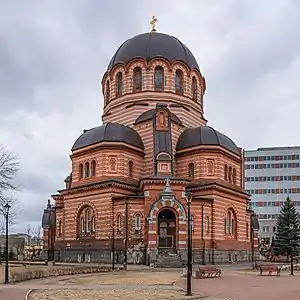

Transportation
The Narva railway station is located on an international railway line between Estonia and Russia (Tallinn–Narva railway). All passenger trains between Russia and Estonia were cancelled during the pandemic in 2020 and the service has not been reassumed. There is a domestic train service between S:t Petersburg and Ivangorod. Hence, it is possible to travel between Narva and S:t Petersburg by train if one crosses the border between Narva and Ivangorod by foot. The walking distance between the border station and Ivangorod train station is about 3,5 km.
Five daily domestic trains run between Narva and Tallinn. Some are express, which takes about 2 1/2 hours.
Adjacent to the central rail station is a central bus station, which has multiple domestic and international connections (including to Russia, Latvia, Lithuania, Poland, Belarus etc.). The bus routes to Russia will cease on February 1st 2024 since the Russian Federation is closing the border between Narva and Ivangorod for trafic - only pedestrians will be permitted to cross the border[52].
There is a general aviation grass airfield near Narva (ICAO: EENA). The strip is 600 meters long.
Sport
The two main professional sports in the city are ice hockey and football.
Narva PSK play at the Narva Ice Hall, which also was the host arena of the 2005 World Junior Ice Hockey Division I Championship Group B.
JK Narva Trans play at the Narva Kreenholm Stadium. They are founding members of the Meistriliiga, and are one of two clubs which have never been relegated from the Estonian top division. They have won 2 Estonian Cups and 2 Estonian Supercups.
Notable residents
- Evert Horn (1585–1615), governor of Narva (1613)
- Ludwig Busbetzky (1687-1699), composer and organist at the German Church in Narva
- Aleksander Promet (1879–1938), artist
- Raimund Kull (1882–1942), conductor and composer
- Adolf Szyszko-Bohusz (1883–1948), architect
- Albert Üksip (1886–1966), botanist
- Emmanuel Steinschneider (1886–1970), professor.
- Nikolai Stepulov (1913–1968), Olympic boxer
- Kersti Merilaas (1913–1986), poet, playwright
- Paul Keres (1916–1975), chess grandmaster
- Paul Felix Schmidt (1916–1984), chess player
- Ortvin Sarapu (1924–1999), chess player
- Valeri Karpin (born 1969), Russian football player
- Maksim Gruznov (1974), football player
- Reinar Hallik (1984), basketball player
- Leo Komarov (1987), ice hockey player
- Alika Milova (2002), singer, represented Estonia in the Eurovision Song Contest 2023
In popular culture
In the first-person shooter video game Squad, the map Narva is loosely based on the real city, containing Narva Castle, Ivangorod Fortress and a southern industrial area.
Friendship and partner cities
Notes
References
- ↑ Population by sex, age and place of residence after the 2017 administrative reform, 1 January. Statistics Estonia.
- 1 2 3 Census 2011: population by ethnic nationality, sex, age group and place of residence. Statistics Estonia.
- 1 2 3 4 5 6 7 Kattago, Siobhan (2008). "Commemorating Liberation and Occupation: War Memorials Along the Road to Narva". Journal of Baltic Studies. 39 (4): 431–449. doi:10.1080/01629770802461225. S2CID 145001694.
- 1 2 3 4 Duncan, W. Raymond (2019). Ethnic Nationalism And Regional Conflict: The Former Soviet Union And Yugoslavia. Routledge. ISBN 9780429715938.
- 1 2 "Üldinfo - Narva Linnavalitsus" [Narva in figures] (PDF). www.narva.ee. 2013.
- ↑ "History of Narva: Formation of city". Narva Museum. Retrieved 19 March 2009.
- ↑ Kriiska, Aivar; Lavento, Mika (2006). "Narva Joaoru asulakohalt leitud keraamika kõrbekihi AMS-dateeringud". Narva Muuseumi Toimetised (in Estonian, English, and Russian) (6). Archived from the original on 20 July 2011. Retrieved 2 April 2009.
- ↑ Raik, Katri (2005). "Miks pidada linna, eriti Narva sünnipäeva?". Narva Muuseumi Toimetised (in Estonian) (5).
- 1 2 3 Kivimäe, Jüri (2004). "Medieval Narva: Featuring a Small Town between East and West". In Brüggemann, Karsten (ed.). Narva and the Baltic Sea Region. Narva: Narva College of the University of Tartu. ISBN 9985-4-0417-3.
- 1 2 3 4 5 "History of Narva: Narva fortifications and Narva Castle". Narva Museum. Retrieved 19 March 2009.
- ↑ "History of Narva: Timeline". Narva Museum. Retrieved 25 March 2009.
- 1 2 3 Raun, Toivo U. (2001). Estonia and the Estonians. Stanford, United States: Hoover Institution Press, Stanford University. ISBN 0-8179-2852-9.
- 1 2 3 4 5 Batt, Judy; Wolczuk, Kataryna, eds. (2002). Region, state and identity in Central and Eastern Europe. London, Portland: Frank Cass Publishers. p. 222. ISBN 0-7146-5243-1. Retrieved 12 November 2009.
- ↑ Нарва: культурно-исторический справочник [Narva: kulturno-istoricheskiy spravochnik] (in Russian). Narva: Narva Museum. 2001.
- ↑ "Old town: Expansion and Tragedy". www.narva.ee. 13 April 2009. Archived from the original on 13 April 2009.
- 1 2 Faure, Gunter; Mensing, Teresa (2012). The Estonians; The long road to independence. Lulu. p. 23. ISBN 9781105530036.
- ↑ "History of Narva: The Old Town of Narva". Narva Museum. Retrieved 19 March 2009.
- 1 2 Vseviov, David (2001). Nõukogudeaegne Narva. Elanikkonna kujunemine 1944–1970 (in Estonian and Russian). Tartu: Okupatsioonide Repressiivpoliitika Uurimise Riiklik Komisjon.
- ↑ "Estonia and Russia: Treaties". Estonian Foreign Ministry. Archived from the original on 2 January 2011. Retrieved 12 November 2009.
Estonia sticks to its former position that it has no territorial claims with respect to Russia, and Narva presently sits peacefully within Estonia's borders. As such, Estonia sees no obstacles for the entry into force of the current treaty.
- ↑ Berg, Eiki. "Milleks meile idapiir ja ilma lepinguta?". Eesti Päevaleht (in Estonian). Archived from the original on 9 October 2007. Retrieved 27 September 2009.
- ↑ "Enn Eesmaa: väide Petseri-soovist on ennekõike provokatiivne". Eesti Päevaleht (in Estonian). Archived from the original on 26 August 2009. Retrieved 27 September 2009.
- ↑ "After 20 years, Russia and Estonia sign border treaty". Reuters. 14 February 2014.
- ↑ Vanttinen, Pekka (15 November 2021). "Russia may finally ratify 2014 border agreement with Estonia". www.euractiv.com.
- ↑ "Katri Raik: Eesti, Venemaa... Ei, ikka Eesti". Delfi.
- 1 2 3 4 5 6 7 Deutsche Welle; BBC (19 June 2022), Najbardziej "rosyjskie" miasto Unii Europejskiej (in Polish), onet.pl
- ↑ "Ministry of Foreign Affairs summons Russian ambassador | Ministry of Foreign Affairs". vm.ee. Retrieved 11 June 2022.
- ↑ "Dispatch from Narva". 26 August 2022.
- ↑ ERR Novosti. В Ивангороде торжественно открыли памятник-танк "Т-34" (Monument-tank "T-34" solemnly opened in Ivangorod) (in Russian) Retrieved 13 September 2022.
- ↑ Population by sex, age and administrative unit or type of settlement, 1 January. Statistics Estonia.
- ↑ "Narva in figures 2008" (PDF). Narva City Government. Archived from the original (PDF) on 5 November 2010. Retrieved 12 November 2009.
- ↑ Census 2011: population by mother tongue, sex and place of residence. Statistics Estonia.
- ↑ Rahvastiku koostis ja korteriolud. 1.III 1934 rahvaloenduse andmed. Vihk II (in Estonian and French). Tallinn: Riigi Statistika Keskbüroo. 1935. hdl:10062/4439.
- ↑ Lewis, Mark (21 January 2013). "Why Europe's Healthiest Economy Has Its Worst Drug Problem". Time.
- ↑ HIV statistics for Estonia: 2001–2006, 2007, 2008
- ↑ "HIV infection rate slows in Estonia". ERR.ee. 5 January 2015.
- ↑ 1922 a. üldrahvalugemise andmed. Vihk IV, Viru maakond. Eesti riikline statistika (in Estonian and French). Tallinn: Riigi Statistika Keskbüroo. 1924. pp. 16–17. hdl:10062/4451.
- ↑ Rahvastiku koostis ja korteriolud. 1.III 1934 rahvaloenduse andmed. Vihk II (in Estonian). Tallinn: Riigi Statistika Keskbüroo. 1935. pp. 47–53. hdl:10062/4439.
- ↑ Eesti Statistika : kuukiri 1942-03/04 (in German and Estonian). Tallinn: Riigi Statistika Keskbüroo. 1942. pp. 66–67.
- ↑ Katus, Kalev; Puur, Allan; Põldma, Asta (2002). Rahvastiku ühtlusarvutatud sündmus- ja loendusstatistika: Ida-Virumaa 1965-1990. Sari C (in Estonian and English). Tallinn: Eesti Kõrgkoolidevaheline Demouuringute Keskus. pp. 31–32. ISBN 9985-820-66-5.
- ↑ Население районов, городов и поселков городского типа Эстонской ССР : по данным Всесоюзной переписи населения на 15 января 1970 года (in Russian). Tallinn: Eesti NSV Statistika Keskvalitsus. 1972. p. 75.
- 1 2 Eesti Vabariigi maakondade, linnade ja alevite rahvastik: 1989. a. rahvaloenduse andmed: statistikakogumik. 1. osa: Rahvaarv rahvuse, perekonnaseisu, hariduse ja elatusallikate järgi. Tallinn: Statistikaamet. 1990. pp. 27, 32. ISBN 978-9949-71-932-7.
- ↑ "RL222: POPULATION BY THE PLACE OF RESIDENCE AND ETHNIC NATIONALITY". Estonian Statistical Database.
- ↑ "RL0429: POPULATION BY ETHNIC NATIONALITY, SEX, AGE GROUP AND PLACE OF RESIDENCE, 31 DECEMBER 2011". Estonian Statistical Database.
- ↑ "RL21429: POPULATION BY ETHNIC NATIONALITY, SEX, AGE GROUP AND PLACE OF RESIDENCE (ADMINISTRATIVE UNIT), 31 DECEMBER 2021". Estonian Statistical Database.
- ↑ "RL21452: AT LEAST 15-YEAR-OLD PERSONS BY RELIGION AND PLACE OF RESIDENCE (ADMINISTRATIVE UNIT), 31 DECEMBER 2021". Estonian Statistical Database.
- ↑ Narva LV Arhitektuuri- ja Linnaplaneerimise Amet Archived 28 August 2008 at the Wayback Machine (in Estonian)
- ↑
"Kliimanormid-Õhutemperatuur" (in Estonian). Estonian Weather Service. Archived from the original on 22 February 2012. Retrieved 24 September 2016.
{{cite web}}: CS1 maint: bot: original URL status unknown (link) - ↑
"Kliimanormid-Sademed, õhuniiskus" (in Estonian). Estonian Weather Service. Archived from the original on 22 February 2012. Retrieved 24 September 2016.
{{cite web}}: CS1 maint: bot: original URL status unknown (link) - ↑
"Kliimanormid-Päikesepaiste kestus" (in Estonian). Estonian Weather Service. Archived from the original on 22 February 2012. Retrieved 24 September 2016.
{{cite web}}: CS1 maint: bot: original URL status unknown (link) - ↑ "Rekordid" (in Estonian). Estonian Weather Service. Retrieved 19 March 2021.
- ↑ "Narva-Jõesuu Sea Temperature". 25 April 2023.
- ↑ https://news.err.ee/1609211776/russia-announces-closing-narva-border-point-to-vehicles-from-february
- ↑ "Narva sõprus- ja partnerlinnad - Rahvusvaheline koostöö - Narva Linnavalitsus". www.narva.ee. Retrieved 13 March 2023.

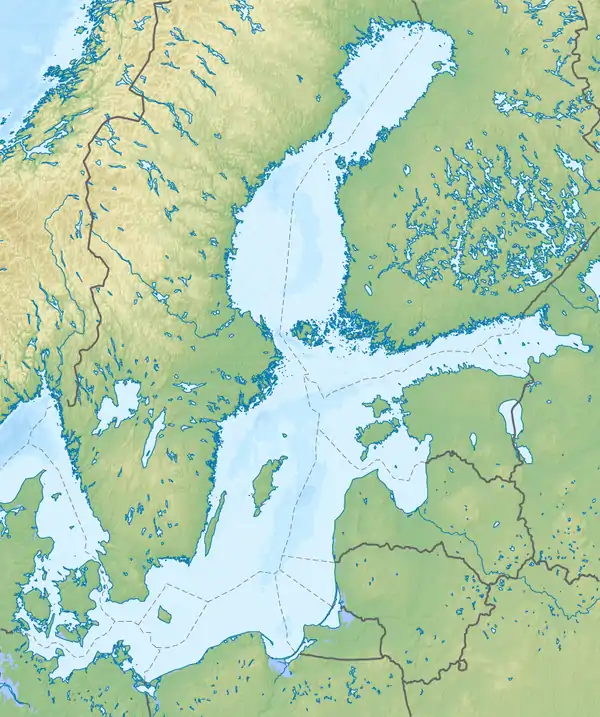
.png.webp)
